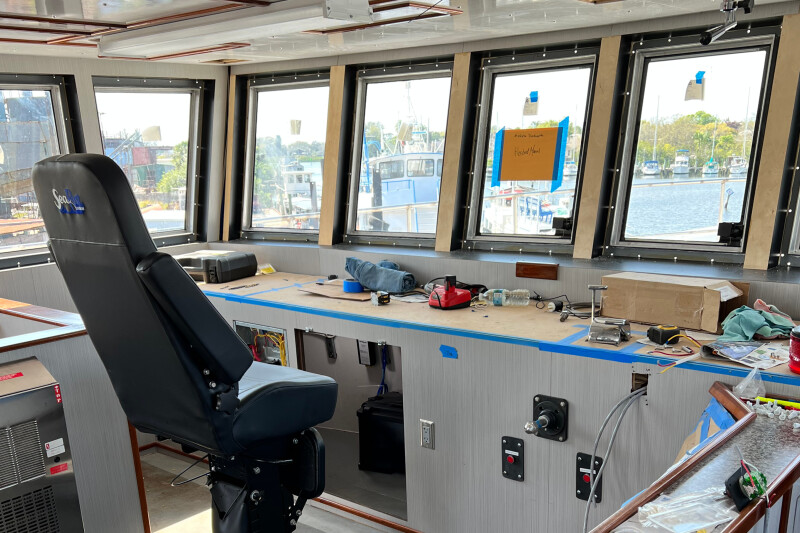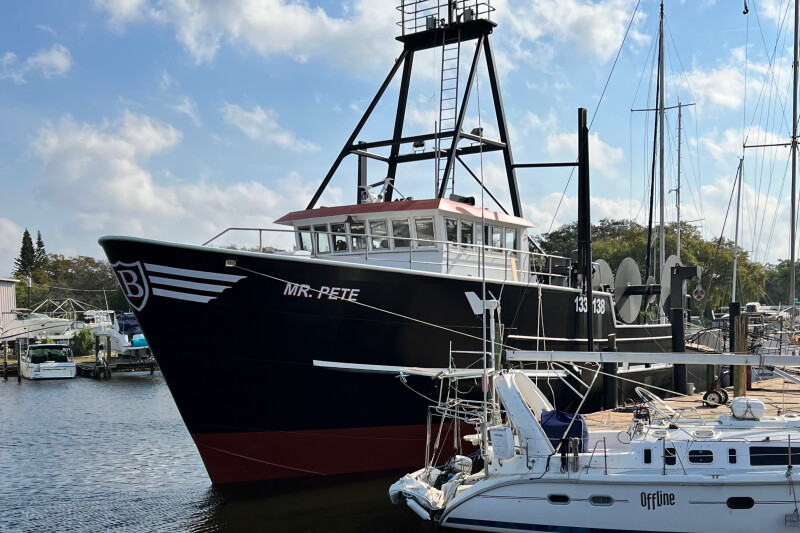When cotton was king in the South, wooden boats built in Maine carried the crop to the mills of England. Now that scallops and lobsters are the kings of New England and Mid-Atlantic fisheries, many of the boats for these fisheries are being built of steel in the South.
In 1988 Tarpon Springs, Fl., boat builder Junior Duckworth delivered a 70-foot dragger to the late Pete Bramante in Boston, Mass. Thirty-five years later, Bramante’s son, Tory – who owns Atlantic Coast Seafood on the Boston Fish Pier – is taking delivery of his own new dragger from Duckworth.
Tory Bramante’s new boat, called the Mr. Pete, after his father, splashed in late February after some delays. “We just had to wait to get some water,” says Duckworth. “It’s hard to get a good tide around here in February.”
Junior Duckworth started his own company in 1976 after working for a Florida boat builder when he got out of the Army in 1965. He has averaged about a boat a year since founding Duckworth Steel Boats in Tarpon Springs.
Duckworth had planned to deliver the Mr. Pete earlier, but a labor shortage slowed things down at the yard. “Right now, we have about 15 people working, including my granddaughter, she’s a welder. I’d like to have about 30, but it’s hard to find people who can do the work these days. Everyone in the business is having trouble.”
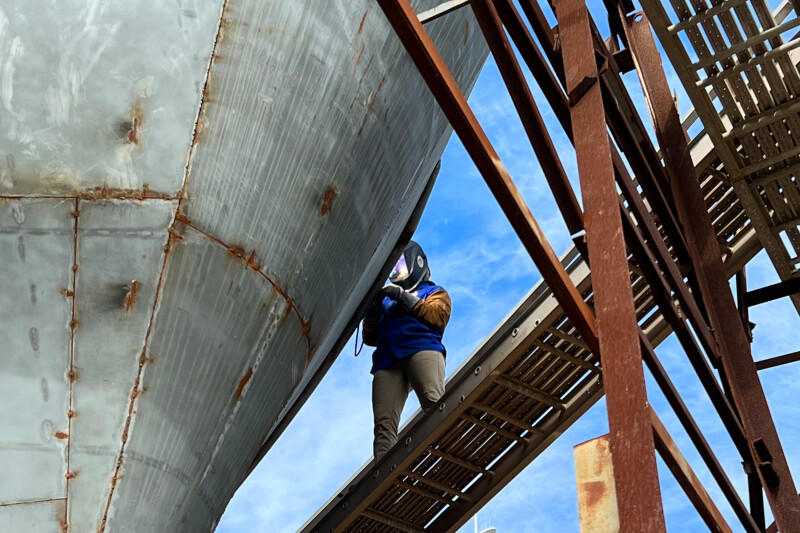
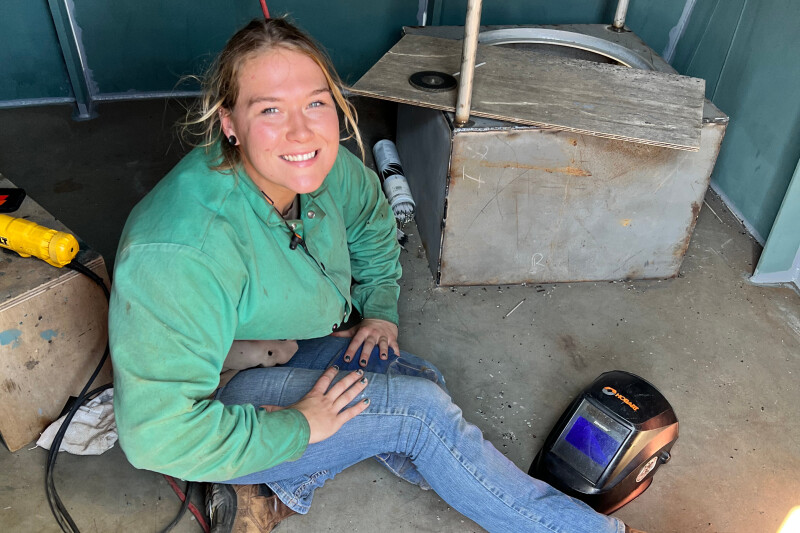
Despite those obstacles, the Duckworth family has crafted a modern trawler for the Bramante family. “This one is 90 feet,” says Duckworth. “It’s 28 feet wide and it’ll draw 13 feet.”
The new vessel was designed by Garrett Norton and the New England naval architects firm Norton and Farrell. “It’s a pretty typical New England dragger,” says Norton. “But at 28 feet it’s wider than they used to be, which gives it significantly more stability. And it’s deeper because Tory wanted more fish hold capacity. We spent a lot of time with him working on how the boat was going to be laid out.” The final hold capacity is 6,500 cubic feet, Norton notes, and the fuel capacity is 11,400 gallons.
While the Mr. Pete is 90 feet overall, its registered length is under 79 feet. Norton is eager for the day the 79-foot limit on fishing vessels that don’t need to be classed under U.S. Coast Guard rules gets changed. “They were supposed to change it to 180 feet when they rewrote the rules. But they forgot to,” says Norton.
Unlike many builders these days, Junior Duckworth does not use CNC (computer numerical code) files and a plasma cutter to cut steel plates for the vessels he builds. “We send him the drawings, and he cuts the steel,” says Norton. According to Norton, the bottom plating is 3/8-inch steel, and the forward side shell is 5/16-inch plate. Midship, side shell frames 23 to 33 are 1/2-inch plate, and aft of frame 33 is 3/4-inch plate. Deck plates are 5/16-inch with 1-inch inserts. Wheelhouse plating is 5/16-inch at the front and 1/4-inch elsewhere.
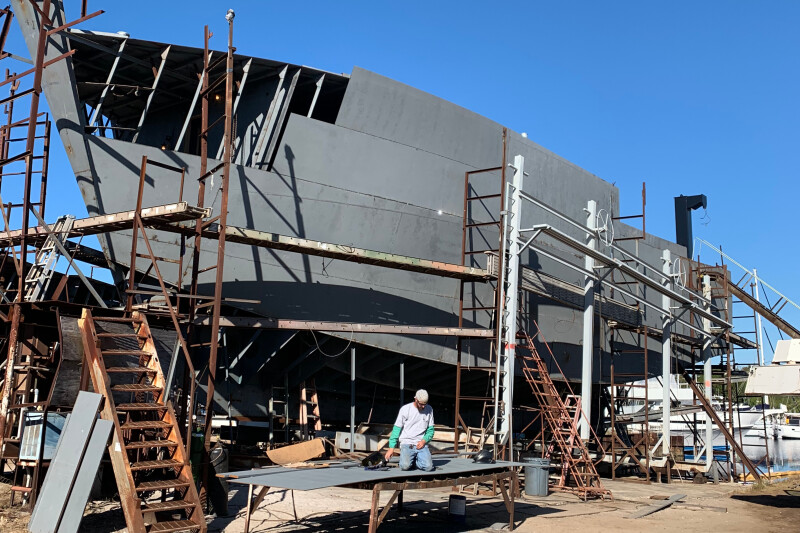
While the Mr. Pete is pretty much a classic New England dragger, the outriggers that became common on most boats since the 1970s have been replaced with hydraulic wings that extend out from the hull below the water line. Duckworth’s first encounter with the wings was in 2020 with the launch of the Heritage, an 85-foot scalloper he built for Nordic Fisheries.
“The Arsheim Junior, a scallop boat we built the year before for Knute Arsheim, went and had their outriggers removed and replaced with wings,” says Duckworth. “They like them better.”
Originally designed by Marine Expert Plus in Quebec, Canada, where they have become the standard, wings are gaining popularity in the U.S. for several reasons. Besides helping lower a vessel’s center of gravity, the wings work to stabilize the vessel on both the up roll and down roll – unlike outriggers and birds, which work only on the up roll. Controlled by hydraulics, the wings can also be lifted out of the water more quickly and easily than outriggers when docking or not needed.
For power, the Mr. Pete has an 800-hp, V-8, Caterpillar C32 Acert, Tier III main engine. According to Caterpillar literature, “the C32 ACERT marine propulsion engine is available at ratings that meet both EPA Tier 3 and IMO II emissions regulations. It has a separate circuit aftercooling system for A through C ratings and a seawater aftercooling system for D and E ratings. The C32 ACERT has seven ratings with Wide Operating Speed Range and extended oil change intervals. Other benefits include proven engine operating history and performance iron with thousands of validation testing hours for quality and durability.”
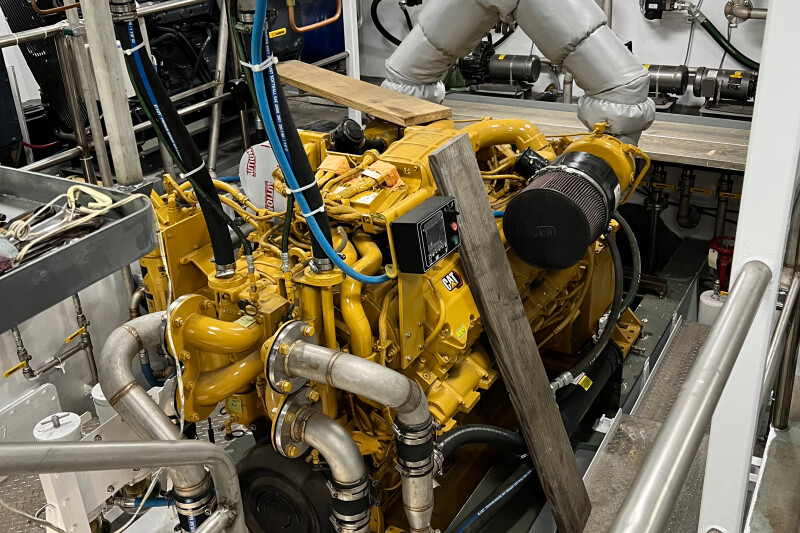
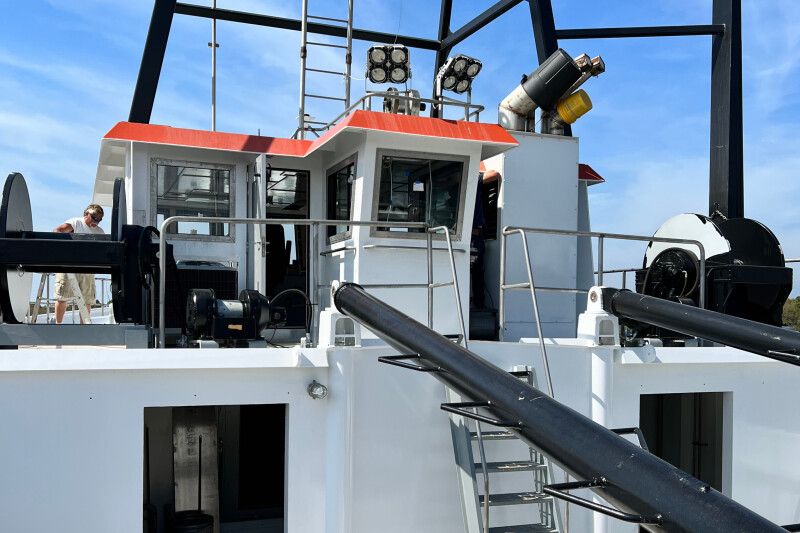
“It’s got two Northern Lights generators, both 65kW,” says Duckworth. “And a Cat C19 hydraulic engine. That one’s around 400 horsepower.”
The main engine has a 6:1 Twin Disc gear turning a 6-inch, 1045 steel shaft with an Aquamet 17 tail shaft. The 75x76, four-blade propeller turns in a 76-inch Kort nozzle. “The prop size is for towing, not for speed,” says designer Norton.
The Cat hydraulic engine will power two net reels on the stern and two Pullmaster trawl winches, as well as other smaller demand machinery and the wings. “It’s got the two net reels and two stern ramps,” says Duckworth. “I guess so if they tear up one net, they can set the other and keep fishing.”
Duckworth does not contract out the galley design as some builders do. “We take the drawings, which are always changing anyway, and work with the owner,” he says. “We find out what they want, and that’s what we build.” The galley and staterooms for the Mr. Pete are on the main deck level. But according to Duckworth, Bramante wanted some additional crew space.
“On the main deck level, it’s got the captain’s stateroom, and two others, one with two bunks and one with four. But then there are more bunks down below near the engine room. Right now, they’re set up for storage, but they have bunks in them because he might rig over for scalloping and he’ll need more crew.”
Tony Vieira, who with his wife Karen owns T&K Marine Electronics in New Bedford, Mass., has flown down once and is scheduled to fly down again to install the electronics.
“It’s my second home,” Vieira quips. “Nobody down there asks me how my flight was anymore because I tell them it was fine; it’s just that my arms are a little tired.”
Vieira flew down in the fall to install all the antennas and was scheduled to return in March to set up all the components of the wheelhouse package. “He’s got a lot,” says Vieira. “Two Furuno radars, the FR8125, that’s a 12kW open array, and an 1835, that’s 4kW in a dome.”
According to Furuno, the 12 kW FR8125 features state-of-the-art signal processing, which makes it easier to identify targets in heavy rain and poor visibility. For tracking the movement of other vessels at sea, “True Motion Trails” can be displayed, as well as AIS/TT target-tracking with a zoom display function. The 1835 features detection of even small targets both at short and long-range and boasts all-new display modes for varying conditions.
According to Vieira, the Mr. Pete’s package also includes an SC76 Furuno satellite compass, a Furuno FCV1150 sounder, and two Furuno GP39 GPS units. “It’s also got a Dirigo 6-inch magnetic compass in a binnacle, a Nobeltec TimeZero Pro 4 plotter, and a P-Sea Windplot II.”
Vieira is installing two Icom 510 VHFs and an Icom 7803 single sideband for communication. But he reports that no decision has been made on satellite communications so far.
“We just have to get that stuff installed and do the sea trials to make sure everything’s working and get it up to New England,” says Junior Duckworth. “After that, we have a scalloper to finish. And after that, I don’t know.”
Like Tory Bramante’s fish house on the Boston Pier, Duckworth Steel Boats are a well-known feature of New England fisheries and are likely to remain so as long as there are fish to catch.
Dale’s grandson Preston works in the yard and is learning the trade, but I had to ask: “Dale, why aren’t you someplace teaching this stuff?”
“Well, I would,” he says. “I’d like to.”
Skilled journeymen in the boatbuilding industry remain in demand, and the knowledge that has been passed down, often for hundreds of years, continues in places like Bayou La Batre. There is a cry for young people throughout the commercial fishing industry, and in some regions, programs exist to teach the skills needed. This writer, for example, is a graduate of the University of Rhode Island’s Fisheries and Marine Technology Program.
Driving out the gate of the Williams Fabrication yard, I wondered if Dale would find a way to share not just his knowledge but his values with more than one young person at a time. The industry is saying that it needs what he and others like him carry in their heads so that the next generation can “set down and get creative” when it comes to designing boats.
